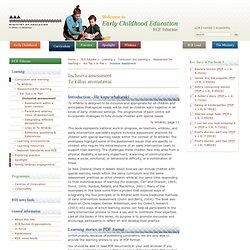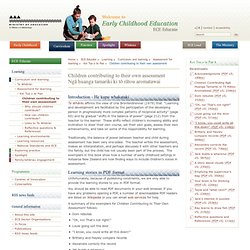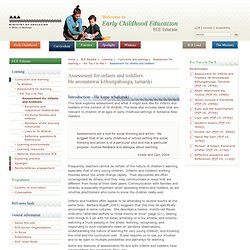

Book 6 -Assessment and learning: Competence. Introduction - He kupu whakataki Exemplars are examples of assessments that make visible learning that is valued so that the learning community (children, families, whānau, teachers, and beyond) can foster ongoing and diverse learning pathways.

Early Childhood Learning and Assessment Exemplar Project Advisory Committee and Co-ordinators, 2002 (Emphasis added) This is the second of three books of exemplars that ask the question “What difference does assessment make to children’s learning?” Assessments can make learning visible and foster learning that is valued. The learning is described as competence in line with the aspiration for children “to grow up as competent and confident learners and communicators” in Te Whāriki (1996, page 9). Book 1 in this series defines assessment for learning as “noticing, recognising, and responding”. One of the parents at an early childhood centre, interviewed by the teacher about her experience of writing learning stories for her son Tom’s folder, said:
Book 9 -Inclusive assessment. Introduction - He kupu whakataki Te Whāriki is designed to be inclusive and appropriate for all children and anticipates that special needs will be met as children learn together in all kinds of early childhood settings.

The programmes of each centre will incorporate strategies to fully include children with special needs. Te Whāriki, page 11 This book represents national work-in-progress, as teachers, whānau, and early intervention specialists explore inclusive assessment practices for children with special learning needs within the context of Te Whāriki. The exemplars highlight some of the assessment issues that are specific to children who require the extra resource of an early intervention team to support their learning. Learning stories in PDF format Unfortunately, because of publishing constraints, we are only able to provide the learning stories to you in PDF format. You should be able to read PDF documents in your web browser. Book 7 -Assessment for learning: Continuity. Book 1 -An introduction to Kei Tua o te Pae. E Tipu e Reanā Hirini Melbournetranslation by Mere Skerrett-White Moe mai rā e te huaI tō moenga paiKaua rā e tahuriTaupoki ki roto i tō papanaruaKia mahana ai Ka tō te marama e tiaho neiKa hī ake ko te rāKei tua o te pae Tipu kē ake koeMe he horoekaTorotika ki te rāWhāia te māramatangaO te hinengaroO te wairua Kia puāwai koe ki te aoKa kitea ō painga Sleep my loved onein your comfortable bed.Don’t be restless.Snuggle up safe and sound in yourduvet so that you are warm.

When the translucent raysof the moon disappear,a new day dawns with the risingof the sun beyond the horizon. So too does the cycle of life continue.Grow up strong and gracious,just like the proud horoeka tree,confident and free.Seek out the secrets of thehidden well-spring of your mindand know the sounds anddreams of your spirit. So you shall blossom into the world,and the world in turn is transformed. Book 4 -Children contributing to their own assessment. Introduction - He kupu whakataki Te Whāriki affirms the view of Urie Bronfenbrenner (1979) that “Learning and development are facilitated by the participation of the developing person in progressively more complex patterns of reciprocal activity” (page 60) and by gradual “shifts in the balance of power” (page 212) from the teacher to the learner.

These shifts reflect children’s increasing ability and inclination to steer their own course, set their own goals, assess their own achievements, and take on some of the responsibility for learning. Traditionally, the balance of power between teacher and child during assessment has been very one-sided. The teacher writes the assessment, makes an interpretation, and perhaps discusses it with other teachers and the family, but the child has not usually been part of the process. The exemplars in this book show how a number of early childhood settings in Aotearoa New Zealand are now finding ways to include children’s voices in assessment. Book 2 -Sociocultural assessment. Book 3 -Bicultural assessment. Book 5 -Assessment and learning: Community. Introduction - He kupu whakataki Exemplars are examples of assessments that make visible learning that is valued so that the learning community (children, families, whānau, teachers, and beyond) can foster ongoing and diverse learning pathways.

Early Childhood Learning and Assessment Exemplar Project AdvisoryCommittee and Co-ordinators, 2002 (emphasis added) Exemplar books 5, 6, and 7 ask the question: “What difference does assessment make to children’s learning?” These exemplar books are about the purposes and consequences of documented assessment in early childhood.1 We know that feedback to children makes a difference to their learning. What difference does documented assessment make? Community: inviting the participation of children, families, whānau, teachers, and beyond; competence: making visible the learning that is valued; continuity: fostering ongoing and diverse pathways.
This book is about the first of these: community. Book 8 -Assessment for infants and toddlers. Introduction - He kupu whakataki This book explores assessment and what it might look like for infants and toddlers in the context of Te Whāriki.

The book also includes ideas that are relevant to children of all ages in early childhood settings in Aotearoa New Zealand. Assessments are a tool for social thinking and action. We suggest that in an early childhood or school setting this social thinking and action is of a particular kind and has a particular purpose: mutual feedback and dialogue about learning. Cowie and Carr, 2004 Frequently, teachers cannot be certain of the nature of children’s learning, especially that of very young children. Infants and toddlers often appear to be attending to several events at the same time.